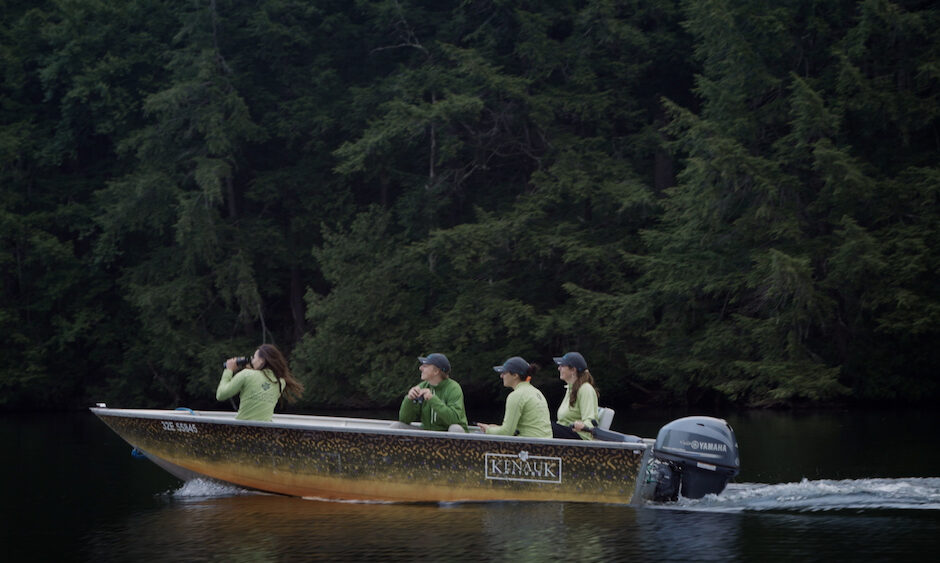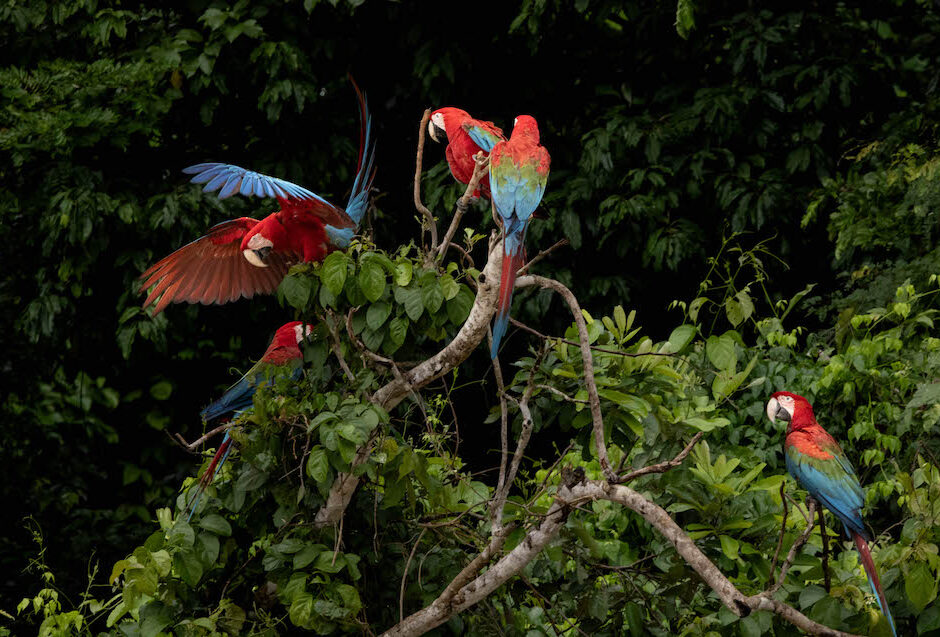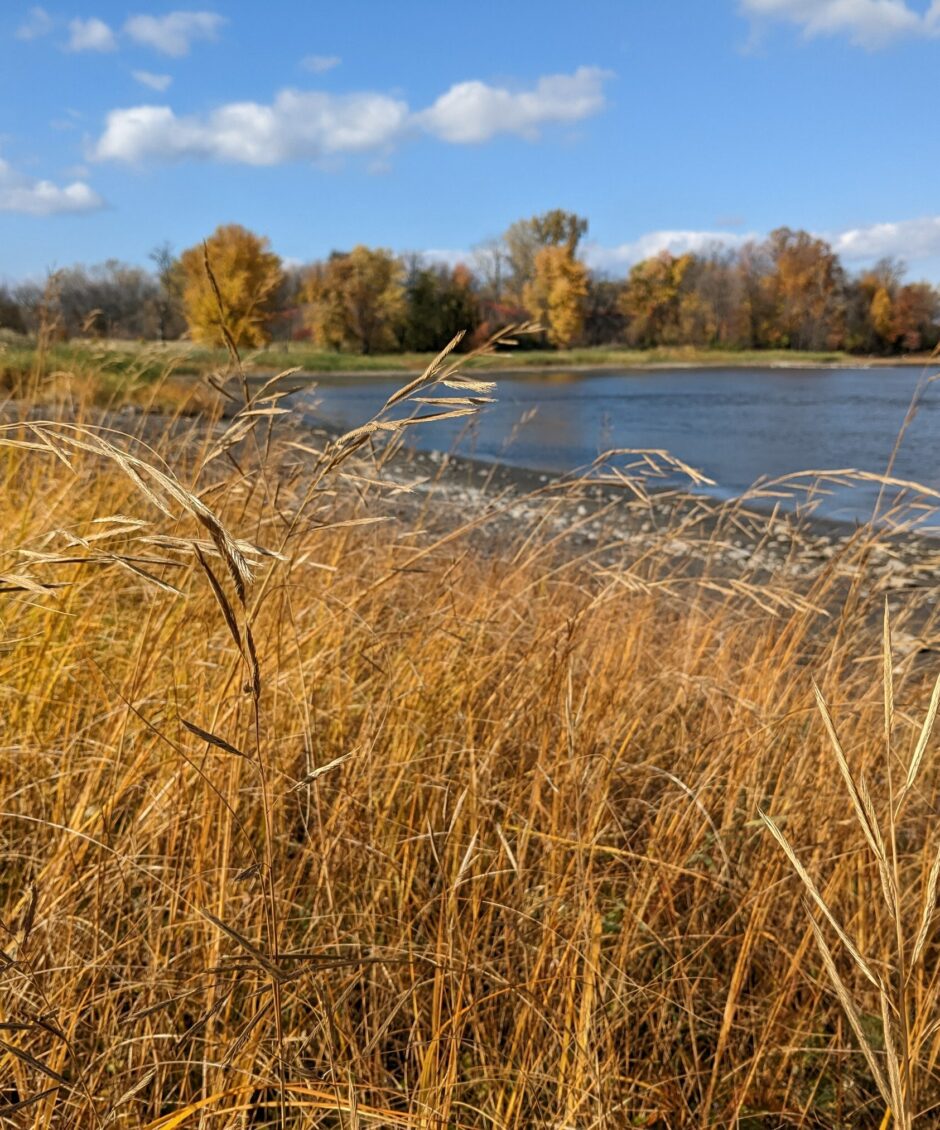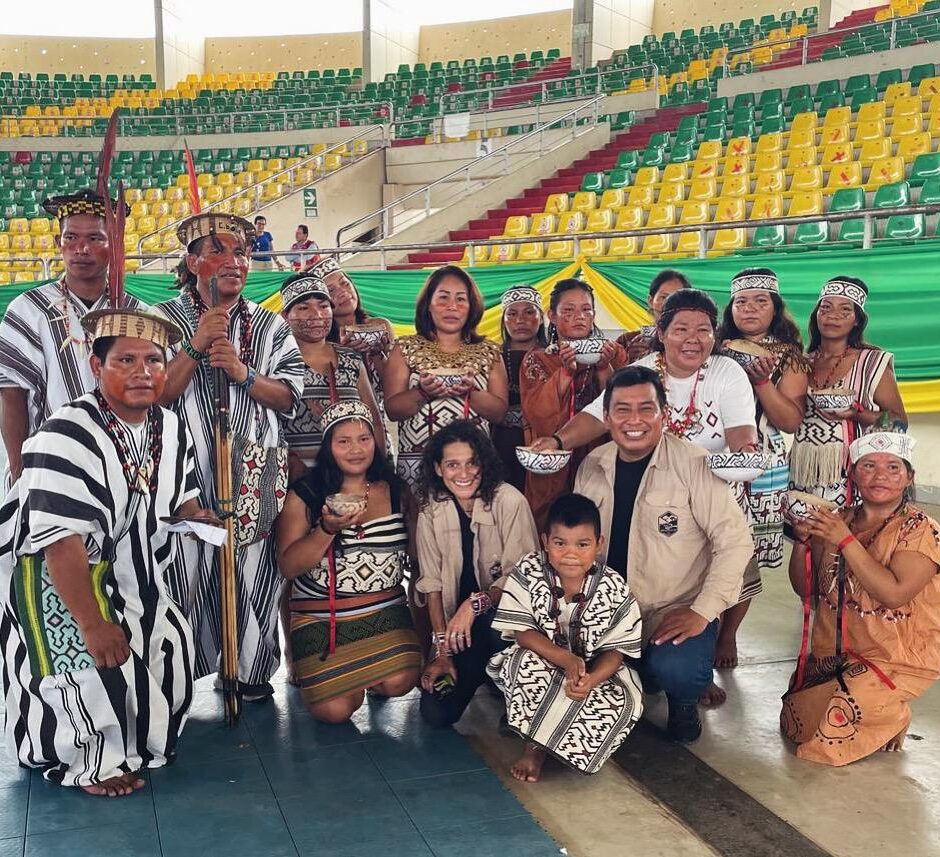Indigenous Artist-Curator Adrian Stimson Sees New Directions for the Earth
Article

In June, we commemorate National Indigenous History Month. During this month, we take time to recognize the rich history, heritage, resilience and diversity of First Nations, Inuit and Métis Peoples across Canada.
We are very proud to welcome Adrian Stimson as Age of Union’s official Indigenous art curator. A member of the Siksika (Blackfoot) Nation in Alberta, Stimson is an interdisciplinary artist who exhibits internationally.
Topics
His current exhibition at the Earth Centre called Anthro-Obscene is a series of paintings and sculptures that invite us to contemplate the impact of our actions on this Earth and realize that if we observe, listen to, and love the world around us, we may be able to change our current direction. The exhibition presents:
– Three paintings made of oil paint, wood ash and feathers on birchwood canvas. They are titled “Awwasukapi” in the Blackfoot language, meaning “many things happening, some good, some bad.”
– Three sculptures featuring a mix of materials and incorporating media like sound or video. They are named “Naamo Ooko’o’wa Omahkokata A’paissapii,” ”Ina’kitapii Sais’skiimoko ooko’o’wa” and “Regalia Naamoi’stotoohsin,” in the Blackfoot language, respectively meaning “Bee Tower and Gopher Looking,” “Little People’s Greenhouse” and “Bumble Bee Regalia.”
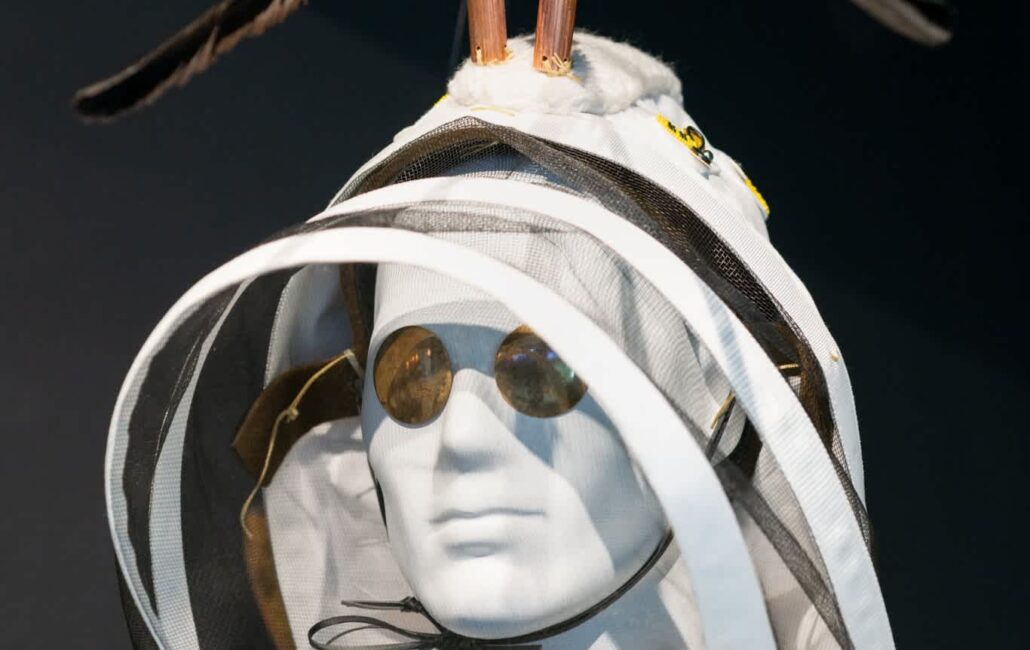
Adrian Stimson’s Artistic Statement of Anthro-Obscene Installation
The entirety of this installation is my contribution to the Gardenship and State project for University London 2021. My intent was to create moments in time where we can contemplate the impact of our actions on this earth. And, that if we observe, listen to, and love the world around us, we may be able to change the current direction in which we are headed.
The series of 3 paintings I call Awwasukapi in my Blackfoot language. In English, this means; many things happening, some good, some bad. It is often used to describe something bad, yet it can be subjective, meaning that good things can come of the bad. Awwasukapi 1,2,3. 2021- 4’ x 5’ Oil paint, wood ash, feathers on Birchwood canvas.
Western Canada has been experiencing more and more wildfires, not only destroying forests and communities but also filling the air with ash particulate, particulate that we all breathe, human and animal, the health effects are immediate for those with health issues and yet unknown health implications for the rest of us. Again, it’s hard to be optimistic when the skies are dulled by the thick smoke day after day. These paintings are an emotive response to the fear and sadness I feel, how we are all caught in these ill winds of change. The flurry of feathers in the wood ash speaks to presence and disappearance, that we all return to ash, that the birds are seeing a mass extinction in our time, in the past half-century, North America has lost 3 billion birds!
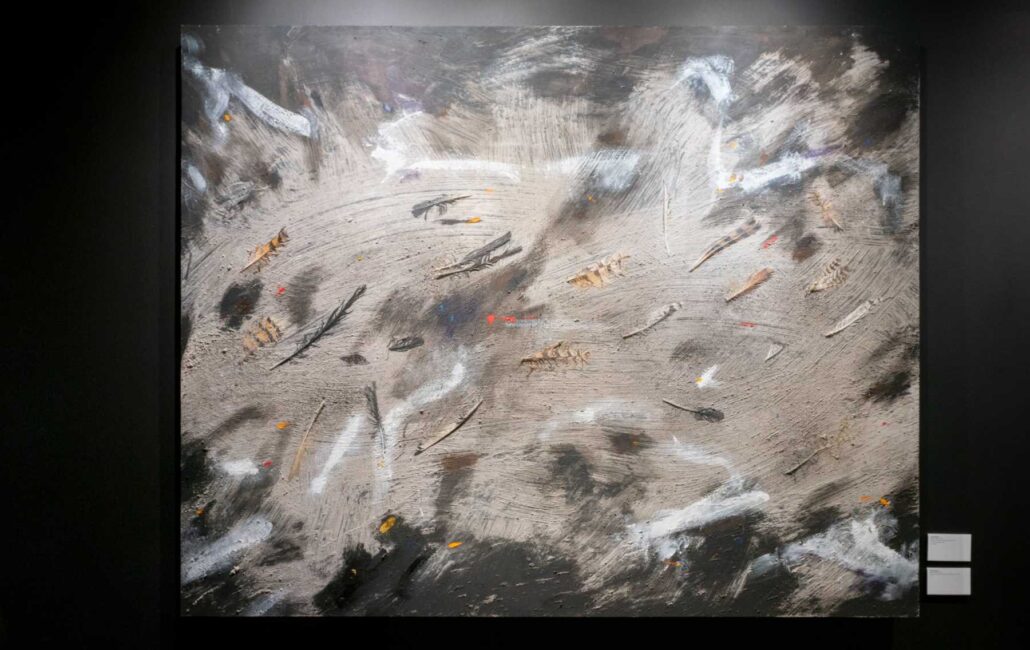
The sculpture I call Naamo Ooko’o’wa Omahkokata A’paissapii in my Blackfoot language. In English, this translates to: Bee Tower and Gopher Looking. Naamo Ooko’o’wa Omahkokata A’paissapii 2021 stained birchwood base with bronze gopher staring up towards a 20’ box tall bee tower, pine wood stained, and gold leafed with bees, with OWL (Stained and gold leafed) perched atop. Light and sound – light emanates from the entry at the base of the tower, and sounds recorded from within our own hives will emanate from within the tower.
I have been Beekeeping for the past 10 years, I undertook it in response to the staggering colony collapses and the real danger that we will lose our pollinators, should they disappear, we will follow quickly. The Bee Tower, painted with Black graphite in clear gesso, 24 k gold leaf bees, ghost bee silhouettes, topped with a copper roof and a Great Horned Owl. In Blackfoot ways of knowing, the owl is greatly respected and has powerful medicines, one fear we have as Blackfoot people is that an owl will land on our roofs, it is a sign of death to come, by placing the owl on the roof of the bee tower, I seek the power of the owl yet also know that the Bees are in trouble and that we must respect and respond to the messages we are given by the animal world. The tower also has light and sound, the light is to mimic the colour of honey or gold within, and the soundtrack is 56:57 minutes long, taken from inside one of my hives, then amplified and mixed, at the end, there is a 5-minute after-hours club disco soundtrack, meant to add humour as well as the idea that “something” is going on in there. The gopher with the gas mask stands in front of the hive, another humourous element, yet by anthropomorphizing the gopher in this way, I seek to give the animals a voice, to honour that we share this world with them.

The sculpture I call Ina’kitapii Sais’skiimoko ooko’o’wa in my Blackfoot language. In English this translates to: Little People’s Greenhouse. Ina’kitapii Sais’skiimoko ooko’o’wa 2021 Birchwood and pine stained, T.V. Monitor, Video with sound.
The Little Peoples Greenhouse is an installation that mimics my actual greenhouse. It is painted with a black graphite gesso mix with a TV monitor embedded in the floor. The 8-minute video is a montage of drone and photos of my home garden and experience of the pandemic in 2020/21. I have called it the “Little Peoples” greenhouse to honour the “little people” of the Blackfoot. They are real and live among us, they take care of us and sometimes play tricks on us. The Blackfoot often give offerings to them in the form of food, little clothing, and tobacco. During the planting of tobacco, offerings are made to the little people to take care of the crop. We must make offerings to them to take care of our gardens, our world.
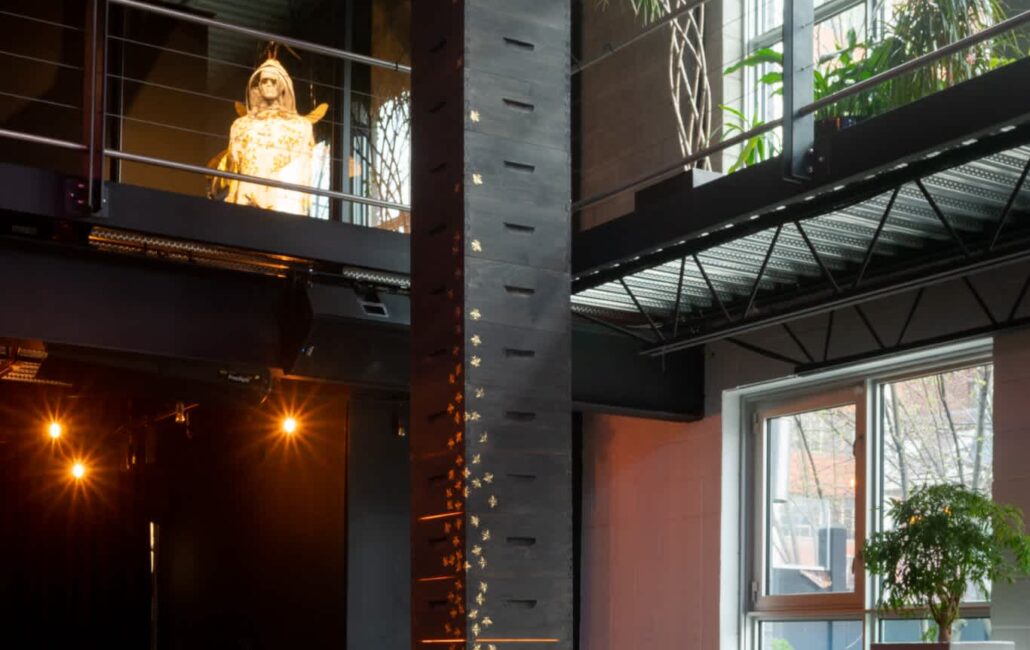
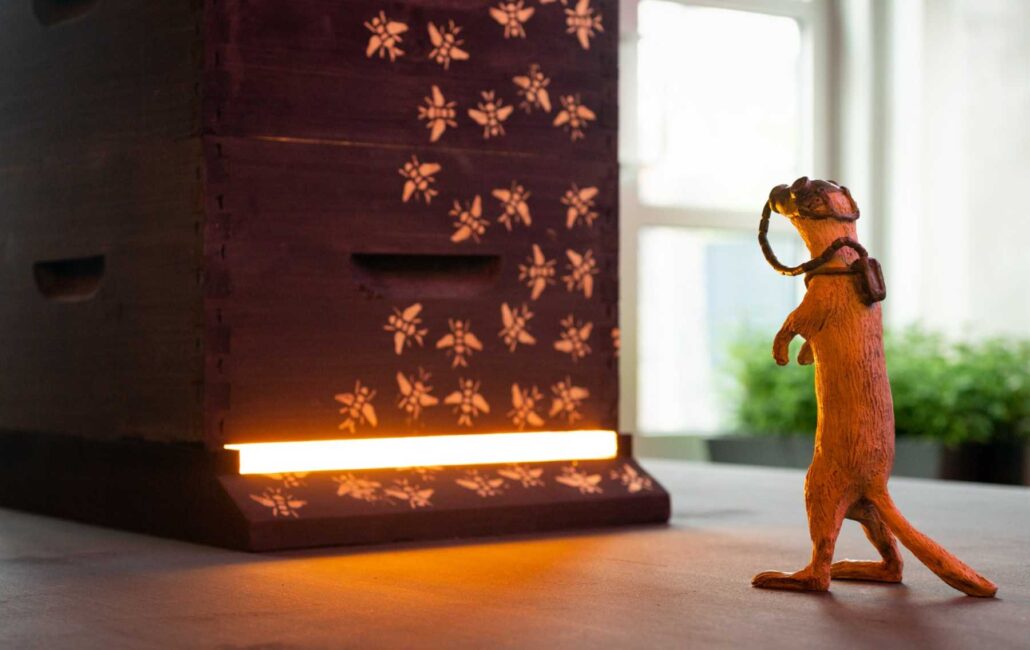
I call this Regalia Naamoi’stotoohsin in my Blackfoot language. In English this translates to Bumble Bee Regalia. Naamoi’stotoohsin 2021, in collaboration with Lucille Wright Payotapaihpiyakii (Dancing the opposite direction woman). Mannequin, Bee Outfit includes coveralls, fur leggings, headgear, beaded gloves, beaded moccasins, dancing stick with shell, leather, bird talon, ribbon, horsehair and feathers, painted bison rawhide shield adorned with feathers, ribbons, and beads. Soundtrack included.
Bumble Bee regalia is a response to both my beekeeping and a Blackfoot society. The Bumble Bee society is a children’s society, one of the first societies we enter. Its purpose is to prepare the children for future societies by teaching them the protocols of the tipi; where to sit, where the altar is and all aspects of the ceremony. They have their own leader, tipi design, outfits, songs, and dances. The children dance like bees and create swarms, they have sharp bangles on their wrists that they “sting” people with, a sign of great respect and you would play as if you were stung. In fact, you must exaggerate the act of getting stung. Currently, the Bumble Bee society is not active. My hope is to be a part of its reactivation. The Bumble Bee regalia is meant to inspire and play with the tenets of the material culture of this society. Evolution is a big part of indigenous knowledge and I seek to evolve the regalia of this society. I have collaborated with a dear friend Lucille Wright, a fantastic beader and cultural knowledge holder. Lucy beaded 300 bees for the regalia and Myrna Youngman attached them. Lucy then beaded the gloves and moccasins to complete the regalia. I created the Bumble Bee shield as a protector for the Bees, Bison rawhide, owl feathers adorn the shield. The Bumble Bee dancing stick is meant to mimic the bangles that the children would wear on their wrists, it is complete with an eagle talon stinger, shells, ribbon, and a horsehair tail. The regalia can be activated through performance and has a 7.5-minute soundtrack for that purpose.
Credits
Photos by Clara Lacasse
Topics
Related
articles
America, Film, News, Project
Age of Union Reveals New “On the Frontline” Episodes Featuring Kenauk Reserve’s Conservation Efforts
America, Explainer, Project, South America
The Braided Lives of Birds and Trees in the Western Amazon
America, Project
Montreal Unveils ‘Grand Parc de l’Est’ Project, Pledging 700 Hectares for Conservation and Urban Green Connectivity
Project
More articles
South America
How Technology is Opening New Windows into Unseen Parts of the Wild
Black Hole Experience, News
Electronic Music Artist Jacques Greene Unveils Bespoke Track “Ligo” for Black Hole Experience at MUTEK
Project, South America
Puerto Nuevo Indigenous Community Secures Land Title After 25 Years of Effort
Black Hole Experience, Explainer





